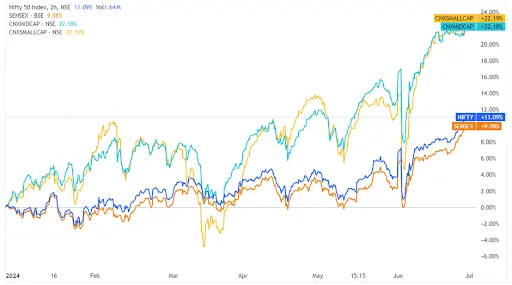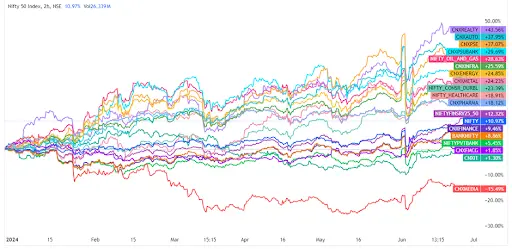Market News
Indian equity market performance in H1 2024; Gains amid volatility with sectoral highlights and economic indicators
.png)
6 min read | Updated on July 02, 2024, 13:18 IST
SUMMARY
2024 witnessed a positive performance from Nifty50 and Sensex gaining by 10.86% and 9.85%, respectively. Though there were hitches at the beginning, mid and small-cap indices surged, despite initial market breaks. Key factors included strong GDP growth, resilient corporate earnings, and moderate inflation. Realty, Auto, and PSU were among the best-performing sectors while Media, FMCG, and IT underperformed

Despite huge foreign capital outflows, steady domestic institutional participation helped stabilize the market.
In the first half of 2024, the Indian Equity market showed positive gains. The Indian stock market barometers NIFTY50 and SENSEX surged by 10.86% and 9.85%. Mid and small-cap stocks continued their rally in the last 6 months, with the Nifty Midcap 100 and Nifty Small-cap 250 Indices gaining 22.18% and 22.19%, respectively.

Starting in January 2024 Indian equities took a break after a strong rally in 2023. The Nifty 50 Index ended January flat but rose again in February. Factors like resilient corporate earnings, strong GDP growth prospects, moderating inflation, and a balanced Interim Budget supported domestic market sentiment.
The IMF revised India's GDP growth forecast to 6.7%, a 40-basis point increase. Despite huge foreign capital outflows, steady domestic institutional participation helped stabilize the market.
In February, Indian equities edged higher but underperformed compared to global emerging and developed markets. Indian debt remained range-bound, despite a global bond market sell-off, supported by fiscal consolidation, lower planned borrowings, and robust foreign capital inflows.
In March, Indian equities were stable and consolidating but mid and small-cap stocks faced selling pressure due to concerns about inflated valuations and SEBI’s instructions to disclose stress test results for small and mid-cap funds. The Nifty Midcap 50 and Nifty Smallcap 50 indices fell by 1.6% and 4.4% in March.
Indian debt markets traded in a range-bound manner in March but sold off in April, following global trends, yet outperformed global counterparts due to easing inflation and robust capital flows.
In April, Indian equities maintained their upward trend. Mid- and small-cap stocks rebounded, with the Nifty Midcap 50 and Nifty Smallcap 50 Indices rising by 4.7% and 11.8% in April. Indian debt declined in April, influenced by deferred rate cut expectations in the US, higher crude oil prices, and foreign capital outflows.
In May 2024, Indian markets reached a milestone, achieving a market capitalization of USD 5 trillion (Rs 415 lakh crore), making it the fourth largest in the world. Over the past 30 years since the NSE was launched in 1994, the Indian markets have grown significantly, with the market cap increasing from ₹3.6 lakh crore to over ₹416 lakh crore today, reflecting a CAGR of 18%. The number of registered investors has also surged, with monthly SIP inflows exceeding ₹20,000 crore.
On June 3, the BSE Sensex and the NSE Nifty zoomed more than 3%, recording their biggest single-day gain in three years and closing at lifetime highs. This happened after the exit polls predicted the return of the Modi government for the third straight term. It led to a total gain of over Rs 11 lakh crore in investors’ wealth.
On June 4, the vote counting day, the benchmark stock indices crashed 6% in the biggest single-day fall in four years, as counting trends showed the ruling BJP might fall short of a clear majority in the Lok Sabha elections. It led to a total loss of over ₹31 lakh crore in investor wealth. After this, the markets rebounded and recovered sharply in the next 4 days to make it a new all-time high. Since then, it has been on a continuous rise to achieve a new all-time high. The Nifty 50 crossed the 24,000 mark at the end of June 2024.
Regarding macroeconomic indicators, high-frequency data continued to show optimism and momentum. April's Composite PMI remained strong at 61.5. Industrial activity, measured by the IIP, showed strong growth, particularly in manufacturing (5.2% YoY) and electricity (8.6% YoY). The merchandise trade deficit expanded to $19.1 billion in April. Retail inflation dropped to its low of 4.75% YoY in May, while wholesale prices rose to a 13-month high of 1.3% YoY. Government GST collections exceeded Rs 2 lakh crore for the first time in April, supported by strong economic activity and a record RBI dividend payout.
Sectoral Gainers and Losers
In the last 6 months, almost all sectors remained on positive gains while only the media sectors have lost a maximum of it. Among all sectors, the Realty sector gained 43.56%, the Auto sector jumped by 37.95% and the most popular sector due to government focus and election the PSU sector gained 37.07%.
On the other hand, the Media sector continued to underperform, losing 15.49% in the last 6 months. While Information Technology and FMCG sector were lagging in the first half of 2024 which gained 1.30% and 1.85%, respectively

Top Performing Sector
Realty Sector
Investors are relatively neutral on the Indian Real Estate industry at the moment, indicating that they anticipate long-term growth rates to remain steady. The earnings for companies in the Real Estate industry have grown 57% per year over the last three years. Revenues for these companies have grown 20% per year. This means that more sales are being generated by these companies overall, and subsequently their profits are increasing too. Investors continue to bet on this sector as government policies continue after the same government comes into power.
Auto Sector
Last year, the domestic auto industry grew by 12.5%. They made big progress in creating vehicles that can run on 20% ethanol, showing their commitment to environmental goals. Additionally, the production of electric vehicles saw a significant boost, with a 90% increase in electric cars and a 30% rise in electric motorcycles and scooters.
PSU Sector
PSU stocks are rising because of several reasons like higher electricity demand, major contracts in the railways sector, more money being spent on defence, and India's strong push towards renewable energy.
Top Lagging Sectors
The Media sector is the most underperforming in the last six months, but looking at the bigger picture the sector always remained in the lagging position. India's media and entertainment sector growth was slow in 2023 which was only 8%.
The Indian IT sector has struggled due to low discretionary spending and high interest rates. However, with potential rate cuts and better economic conditions in developed markets, there is hope that spending will increase, boosting IT companies' earnings. These companies have also worked on reducing costs and improving efficiency to enhance their profitability.
The FMCG index dropped in 2024 after a strong 2023 due to several factors. Economic changes affected consumer spending, inflation raised costs, and new regulations impacted certain sectors like tobacco. Additionally, consumer preferences shifted towards sustainable and health-conscious products.
Moreover, FMCG companies experienced a slow performance in the December quarter (Q3FY24) due to weak rural demand and increased competition, which slowed volume growth. Even though gross margins improved thanks to stable raw material prices, higher advertising costs might temporarily reduce EBITDA margins. The FMCG companies saw a positive year-end of FY24 and the expectation of government push for defensive sectors made recovery signs in June 2024.
About The Author
Next Story

